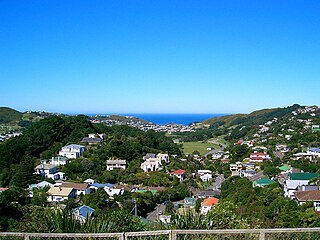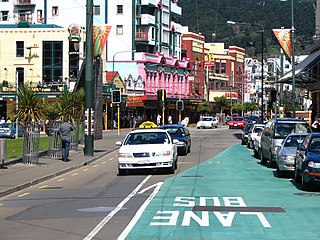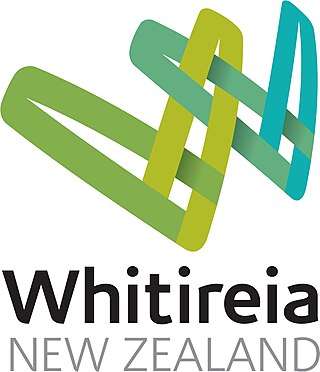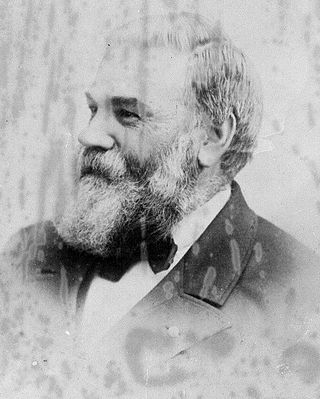Related Research Articles

Vogeltown is a hillside suburb of Wellington, New Zealand, on the eastern slopes of Brooklyn and overlooking Newtown. It is sometimes considered part of Mornington.

The Aro Valley forms a small inner-city suburb of Wellington in New Zealand. It takes its name from the stream which originally flowed where modern Epuni Street is. The stream's Māori name was originally Wai-Mapihi, but it was commonly called Te Aro Stream due to it running through the Te Aro flat.

Te Aro is an inner-city suburb of Wellington, New Zealand. It comprises the southern part of the central business district including the majority of the city's entertainment district and covers the mostly flat area of city between The Terrace and Cambridge Terrace at the base of Mount Victoria.
Shona Rapira Davies is a sculptor and painter of Ngātiwai ki Aotea tribal descent. Currently residing in Wellington New Zealand.

The Te Aro Extension, also known as the Te Aro Branch, was a short branch line railway in Wellington, New Zealand continuing the Wairarapa Line southwards. It operated from 1893 until 1917.

Whitireia New Zealand, previously called Whitireia Community Polytechnic and Parumoana Community College, is a government-owned and funded tertiary education institute in New Zealand. It was established in 1986 on the shores of Porirua Harbour and today has 7,500 students, with campuses in Auckland, Wellington, Petone and Porirua.

Charles Houghton Mills was a member of parliament for Waimea and Wairau, in the South Island of New Zealand.
Wellington South is a former New Zealand parliamentary electorate. It existed for two periods between 1881 and 1946. It was represented by seven Members of Parliament.
Western Maori was one of New Zealand's four original parliamentary Māori electorates established in 1868, along with Northern Maori, Eastern Maori and Southern Maori. In 1996, with the introduction of MMP, the Maori electorates were updated, and Western Maori was replaced with the Te Tai Hauāuru and Te Puku O Te Whenua electorates.
Eastern Maori was one of New Zealand's four original parliamentary Māori electorates established in 1868, along with Northern Maori, Western Maori and Southern Maori. In 1996, with the introduction of MMP, the Maori electorates were updated, and Eastern Maori was replaced with the Te Tai Rawhiti and Te Puku O Te Whenua electorates.
Roland Sapsford is a former male co-convenor of the Green Party of Aotearoa New Zealand. The female co-convenor in the latter part of his office was Georgina Morrison. Sapsford was elected co-convenor in a contested election at the Green Party AGM in 2006, at the same time as former male co-leader Russel Norman's election. He stood down in June 2012 after six years, during which the Party's finances and organisation were significantly enhanced.
Inangahua is a former parliamentary electorate in the Buller District, which is part of the West Coast region of New Zealand, from 1881 to 1896. The town of Inangahua Junction, which gave the electorate its name, was located in the adjacent Buller electorate until 1887.
Wellington East was a parliamentary electorate in the eastern suburbs of Wellington, New Zealand from 1887 to 1890 and from 1905 to 1946. It was succeeded by the Miramar electorate. The electorate was represented by seven Members of Parliament.
Te Aro was a parliamentary electorate in Wellington, New Zealand from 1881 to 1890. It covered the southern area of the central business district. During the three parliamentary terms of its existence, the electorate was represented by three Members of Parliament.
Wellington, was a parliamentary electorate in Wellington, New Zealand. It existed from 1853 to 1905 with a break in the 1880s. It was a multi-member electorate. The electorate was represented, over the years, by 24 members of parliament.
Te Aroha was a parliamentary electorate in the Waikato region of New Zealand from 1890 to 1893. The electorate was represented by two Members of Parliament. The current Te Aroha ward is represented by the Matamata-Piako District in the Waikato region of New Zealand.
Andrew Agnew Stuart Menteath (1853–1916) was a 19th-century Member of Parliament from Westland, New Zealand.

Francis Humphris Fraser (1833–1911) was a politician in Wellington, New Zealand.

Te Aro railway station was a station in Wellington, New Zealand, near what is now the corner of Wakefield and Tory Streets. Opened in 1893 it was one of only three stations in the city - the other two were Wellington railway station on Featherston Street, renamed Lambton railway station in December 1908, which was the main New Zealand Railways Department station, and Thorndon railway station off Thorndon Quay, the southern terminus of the private Wellington and Manawatu Railway.
Mavea is an Oceanic language spoken on Mavea Island in Vanuatu, off the eastern coast of Espiritu Santo. It belongs to the North–Central Vanuatu linkage of Southern Oceanic. The total population of the island is approximately 172, with only 34 fluent speakers of the Mavea language reported in 2008.